Fashion for a healthy and active lifestyle returned scooters to the store shelves. Now not only small, but also big boys and girls can drive them through the streets. In addition, the family of two-wheeled vehicles has grown significantly. After "crossing" of scooters with bicycles and skateboards, many interesting models appeared, on which you can go to work, climb down the mountain slopes and make dizzying tricks. It's time to get acquainted with the novelties, and also to understand what criteria you need to pay attention to choose the right scooter.
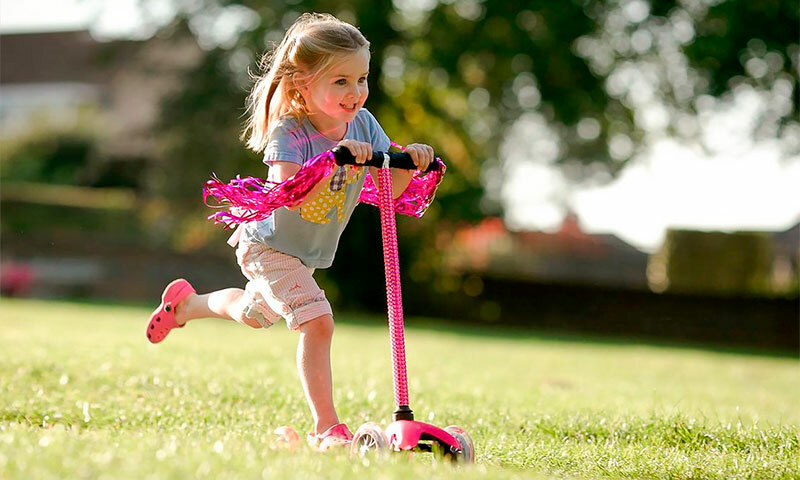
Contents:

The best scooter manufacturers
The best scooter manufacturers - which firm to choose
If you need a toy for one season, but really a quality oneand a solid device, choose models from well-known manufacturers. They cherish their name, and do not release low-grade shells to the market.
Scooters of the following brands will be a good choice:
1. Razor
2. Micro
3. Kettler
4. JD Bug
5. Explore
In our ranking of the best scooters for children you will find a description of the models of these and other famouscompanies. But before buying it is still to understand how modern scooters are and what to look for when choosing.
The device and principle of the scooter
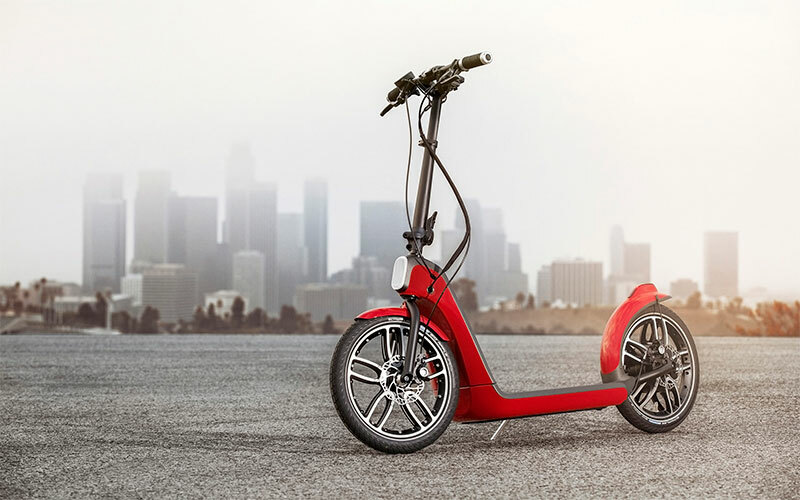
Scooter is a cross between a bicycle and a skateboard. It consists of the following parts:
1. Frame - the bearing base of any scooter, is made of steel, an alloy of aluminum or magnesium. Some models have a folding function for convenient storage and carrying.
2. Deck - foot pad.
3. Steering wheel - can be adjustable and unregulated, T-shaped, "bicycle" design or generally performed as a joystick.
4. Wheels - usually on the scooter there are 2 of them, but today there are also more stable models, where the wheels can be both 3 and 4.
5. Shock-absorbers - not installed on all vehicles, but if there is one, a ride on the scooterwill be more comfortable due to the softening of shocks and vibrations.
6. The brake system.
As for the principle of the scooter's operation, nothing has changed in the last 200 years. To move, you still have to push off the ground with your foot, controlling the movement with the help of a simple helm. The only exceptions are electric cars with a motor and even a seat, but we do not consider them in this review.
Kinds of scooters
Classic two-wheeled
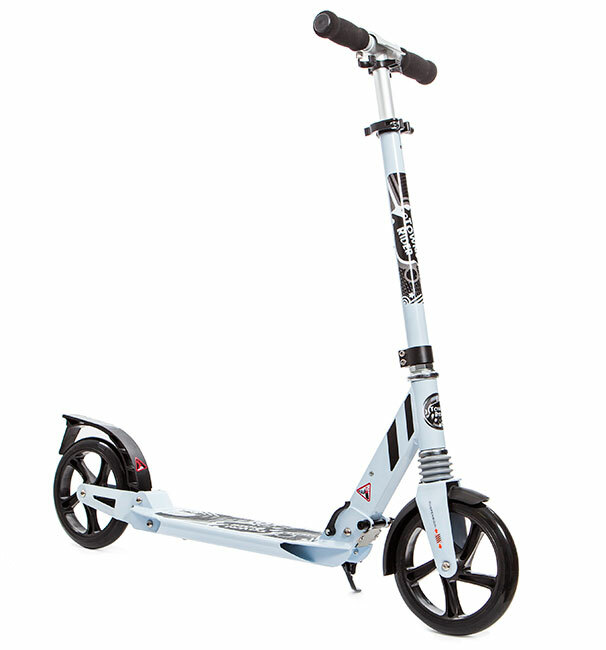
The largest family of shells, which includes both children's models for conventional pokatushek, and adult versions designed for movement around the city. The latter, as a rule, are equipped with a good cushioning system, and wheels with a diameter of 150-250 mm allow you to calmly overcome cracks and potholes in the asphalt.
Pros:
- Comfortable driving in a city;
- Often have a folding mechanism;
- Light weight( up to 5 kg);
- With sufficient diameter, the wheels are well dispersed;
- Good physical load for the owner;
- Low price.
Cons:
- Requires ongoing maintenance;
- Not suitable for performing tricks.
Footbikes( bicycles)
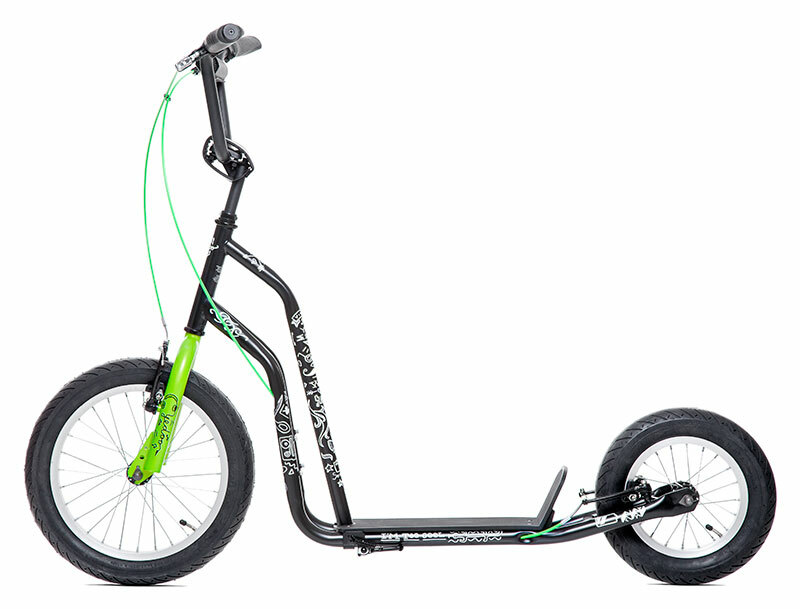
These SUVs have much in common with bicycles - at least, full-size wheels up to 29 "in diameter( the rear is usually slightly smaller).The footboys are well dispersed and maintain the speed for longer, however they require considerable effort from the rider.
Pros:
- High speed and good rolling;
- Possibility to "take" various obstacles;
- Many bicycle parts - no problems with replacement;
- It's easy to customize;
- Hand brake;
- The shock-absorbing front fork.
Cons:
- Dimensions;
- Large load on the feet.
Kickboards
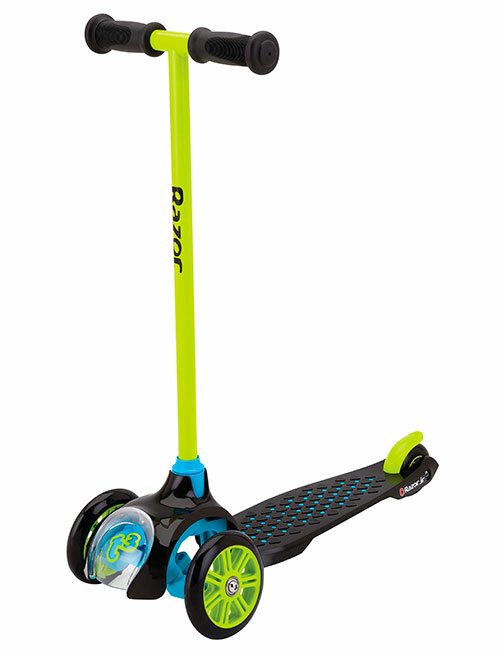
These units, naportiv - not far away from skateboards. Here is a short but wide deck, and instead of 2 wheels there are as many as 3, with the main pair standing in front. This solution allows you to use a different technique of driving, deflecting the deck and thereby forcing the device to turn - like on a skateboard. This is also facilitated by replacing the classic T-shaped steering wheel with a joystick.
Pros:
- Stability;
- You can develop a good speed;
- Convenience in transportation;
- The control is carried out not only by the rudder, but also by the feet;
- Foot brake on the rear wheel.
Cons:
- Large turning radius;
- High cost.
Trikes( they are the same thriders)

No need to be confused with trike-bikes. This is also a three-wheeled scooter, but from kickboarding they are distinguished by 2 shortened decks - one for each leg. Sometimes the support platforms for the trikes are made in the form of a transverse board. Such models are often called inertial scooters, since they can be moved without touching the ground with their feet. In the basic configuration, the triders usually have 2 foot brakes, but for the convenience of control, they are often installed manually.
Pros:
- Maximum stability;
- Attractive appearance;
- You do not have to constantly push off from the ground;
- You can perform various tricks and tricks;
- Convenient control;
- A full load on the muscles of the legs and body.
Cons:
- Demanding quality asphalt;
- At first it is difficult to maintain balance.
Stunt( sport)
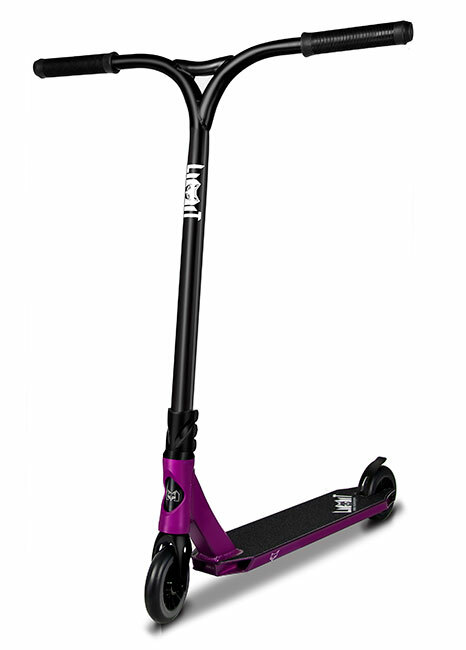
These models have a reinforced non-separable and unregulated frame, as well as small wheels( 100-125 mm).However, this does not mean that they go slowly - on the track these scooters develop a decent speed thanks to bearings of high accuracy class. The stunt units look a little childish, but in fact they can withstand heavy loads and jumps.
Pros:
- Very durable;
- Maneuverable;
- Rapid acceleration in short sections;
- Convenient to operate.
Cons:
- Not suitable for riding on ordinary roads;
- Unregulated steering height;
- High cost with minimal functionality.
Deer-scooters
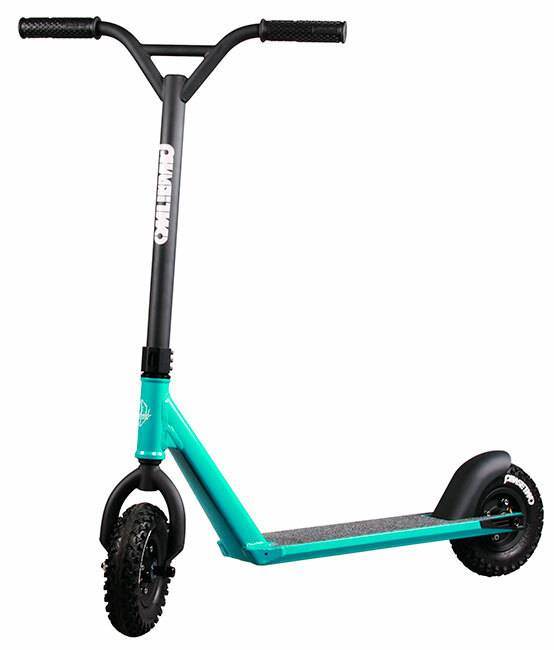
A variety of sporting equipment, only this time not for smooth seats, but for extreme skating on any off-road. These models have wide inflatable wheels with a powerful protector and a single reinforced frame - all with the same unregulated steering wheel.
Pros:
- Reinforced construction;
- Excellent cross-country ability;
- Ability to perform tricks;
- Speed dials well;
- Convenient to operate.
Cons:
- It takes a lot of effort to move;
- High cost.
Scooter selection parameters
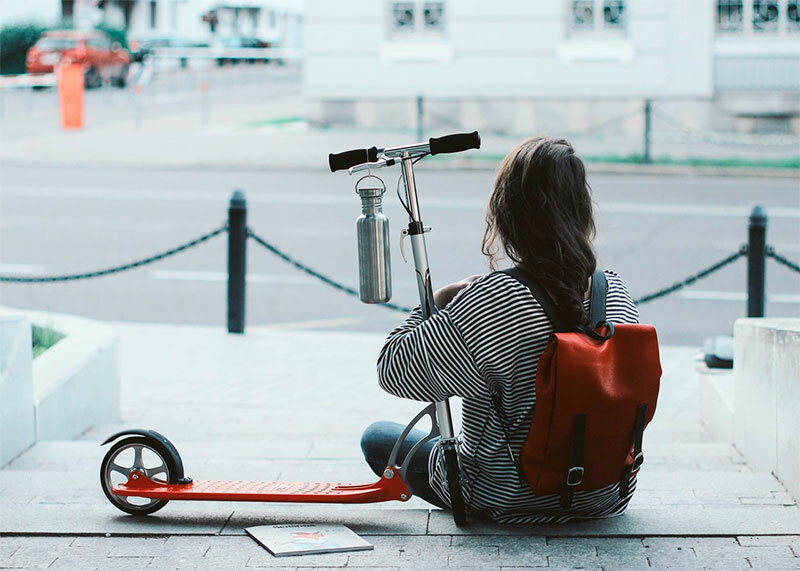
Frame material
Scooter frames are made of three main alloys:
1. Steel is the most reliable and cheapest option, but such an aggregate is quite heavy.
2. Aluminum is much lighter, more resistant to corrosion, but does not have sufficient strength.
3. Magnesium alloy is an ideal combination of light weight and durability, but it is very expensive.
Weight and permissible load
The optimal weight for a child is the weight of a scooter from 3 to 5 kg - so that a small rider can lift it from the ground, and he does not get injured in case of a fall. Such models usually have a maximum "carrying capacity" of up to 50 kg, and it is better not to overload the projectile. Adult equipment can withstand a rider weighing from 50 to 120 kg and, depending on the material of manufacture, can weigh 5-15 kg.
Dimensions and features of the
deck The platform can be rigidly fixed to the frame, ensuring maximum controllability of the scooter during the performance of tricks and tricks. There are also decks on a flexible coupler, as in a kickboard. These serve to facilitate the control of the scooter.
But the main thing is the size of the platform. It depends on it, how convenient it will be for you to ride. Deck of children's scooter should be 30-40 cm in length, and up to 20 cm in width. Such a board will allow you to better balance, and overall controllability of the scooter from this increases. The sizes of adult models can reach 50-100 cm by 20-30 cm.
Also pay attention to the ground clearance - the height of the platform. On the roads and when moving around the city it is better to ride a scooter with a large clearance in order not to hit the bottom. A low deck is ideal for performing tricks on special sites.
Steering wheel
The shape here does not play a special role, especially as it is determined by the design of the scooter itself. Where it is more important to choose a convenient height, because many models it is unregulated. On the market you can find shells with a steering column from 42 to 110 cm in length - look for devices suitable for your growth and riding style.
It is better to take a child's scooter with a telescoping steering wheel at once, so that it "grows up" with the child. When buying, ask the baby to stand on the deck - from this position the optimal height of the stand will be one in which the elbows of the rider will be slightly bent.
For a scooter that will not be operated under extreme conditions, not only adjustment, but also the possibility of steering wheel folding is allowed. This will simplify the storage of transport and its transportation. Sports models and SUVs should have an exceptionally integral design - for maximum reliability.
Wheels
Usually scooters have 2 wheels, but we have already got acquainted with other models. Extra wheels do not affect the performance of the projectile in general, but add stability to it.
Wheels for scooters are often made of PVC or polyurethane - relatively inexpensive and moderately noisy materials. They are not susceptible to damage( cuts or punctures).On sports models intended for driving on impassability and rough terrain, it is better to show itself inflatable rubber wheels. Budget and stunt scooters can be equipped with plastic products - they are tough, loud rumbling, but they walk long enough.
As for the size, the speed of your device depends on it. The larger the diameter of the wheels, the faster you can accelerate.
For each variety of projectiles there are their optimum sizes:
- Stunts - 100 mm;
- Urban - from 150 to 200 mm;
- Footboys - over 200 mm.
When buying, pay attention to the rigidity of the wheels. Soft with marking 78А-82А perfectly keep on the road, literally "sticking" to it - they are good for using for short trips on bad asphalt. Alas, they wear out quickly and will later require replacement. If the road surface is fairly flat, it is better to choose a high rigidity - up to a maximum of 97A.
Brake
Today, the brakes are installed even on the simplest children's scooters. Choose a convenient system for yourself you have to yourself - you just need to know what the manufacturers of sports equipment offer. There are two main options.
The first is a standard foot brake. Often its role is performed by a reinforced rear wing: you step on it with your foot, and it clamps the wheel, causing the scooter to stop. Hand brakes are borrowed from bicycles, however, the most reliable and responsive disk mechanics is taken as a basis. In good scooters you can simultaneously meet both types of brakes.
Which scooter to choose
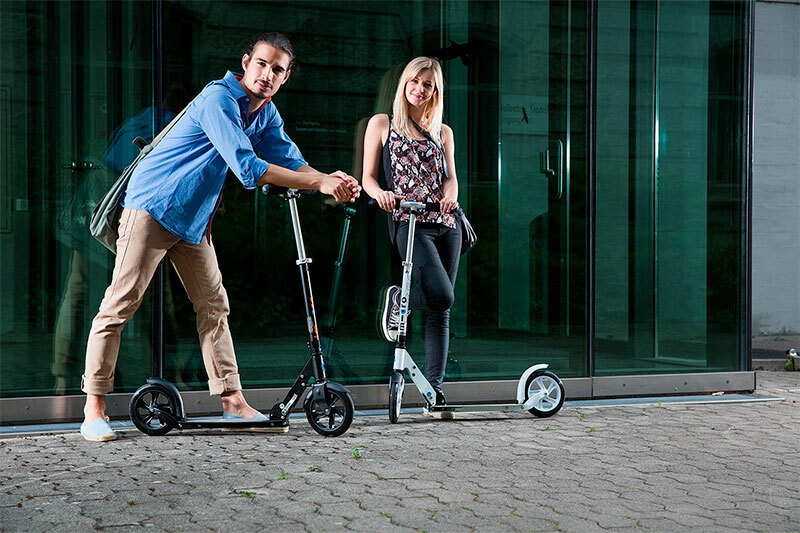
1. For those who like frequent walks in the city or in the park, and also get to work / study on a two-wheeled transport, ordinary city scooters of a collapsible design will do. Here you need good shock absorbers and soft wheels up to 84A with bearings of class ABEC3.It is necessary for comfortable and quick movement along asphalt streets. It is advisable that both a manual and a foot brake are installed on the scooter - so you can definitely stop in time.
2. For full-fledged sports activities on the special site, you need a trick scooter with small wheels( about 100 mm) and expensive bearings ABEC5.The whole construction should be rigid - from the deck to the steering wheel, and the frame reinforced( ideally steel).Only such a shell is able to withstand the most daring jumps and tricks.
3. If you prefer to ride away from city streets, choose a footbasket or a dart-scooter. The first is suitable for pleasant pokatushek, the second - for a real extreme and cross-country racing. In both cases, it is worth opting for a light and solid frame made of magnesium alloy, as well as large inflatable wheels with wide tires and a protector.
4. It is better for a child to buy not just a scooter, but a stable model such as a kickboard or tridger. The main thing is that the steering wheel is adjusted in height, and the device was not heavier than 5 kg. Pay attention also to the type of bearings: if the child is still very small, they should have the lowest class ABEC1, which will not allow the karapuza to be greatly accelerated. For schoolboys it is possible to take transport with "adult" bearings АВЕС3.Also, children need soft wheels with a stiffness of about 78A-82A, so that they do not slip on the road, but cling to it.
Cost of scooters
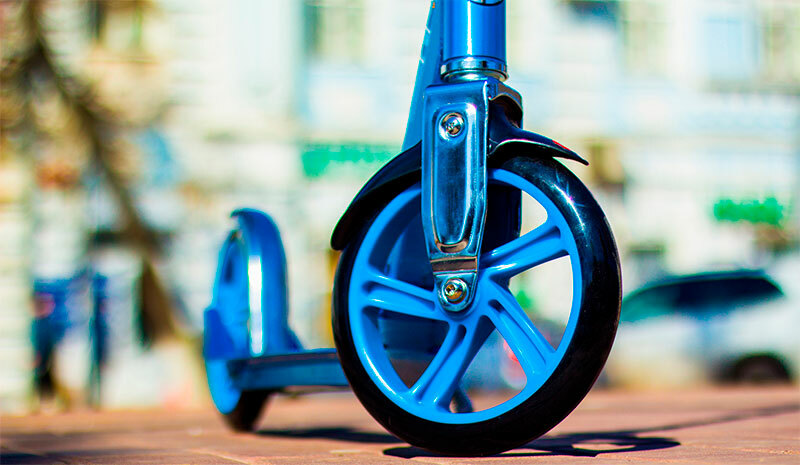
1. The simplest children's scooter can be bought for only 600-1000 rubles.
2. Standard city models cost from 3 to 40 thousand rubles.
3. Footbikes go for the price of bicycles: 7500-90000 rub.
4. Thriders are the cheapest( due to the abundance of children's models): 900-12000 rubles. Kickboards are not much more expensive - from 1 to 17 thousand.
5. Stunt scooters cost athletes 2-36 thousand rubles. Dirt off-road cars cost no more than 25 thousand.



